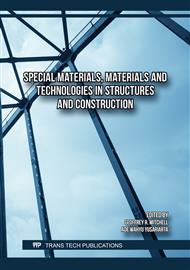p.49
p.63
p.75
p.89
p.101
p.115
p.125
p.131
p.137
Manufacturing and Evaluation of the Mechanical Response of Geopolymeric Mortars with Raw Materials from Khapia Hill in Puno (Peru)
Abstract:
This work presents interesting results on the manufacturing and mechanical response of new mixtures for geopolymeric mortars using soils collected from sites near the Khapia hill located in the Puno region (Peru). Four types of soils were collected and used as binder raw material within a geopolymeric mortar mixture with a binder: sand ratio of 1:3. In parallel and for comparative purposes, the mechanical response of conventional Portland cement mortars was manufactured and evaluated, with a binder: fine sand volumetric ratio also of 1:3. To obtain the geopolymeric mortars, the sodium hydroxide solution with a molarity of 12 was considered as the liquid phase. While for the conventional Portland cement mortar, water was used. For all cases, the liquid phase: binder ratio was 0.6. The mechanical results were variable, with maximum average mechanical strength values between 30.1 and 45.4 MPa for geopolymeric mortars and 37.4 MPa for conventional mortars. On the other hand, Young's modulus values were found between 5.9 and 10.4 GPa for geopolymeric mortars and 8.8 GPa for conventional mortars. Regarding the porosity estimated from real and apparent densities, values between 27.2 and 28.3 % were found for geopolymeric mortars and 30.2 % for conventional mortars. The microstructure found for both types of mortars studied was very similar, all mortars consisted of two well-identified phases, a continuous and homogeneous phase of binder (geopolymeric or Portland cement) that surrounded another dispersed phase of aggregate particles (fine sand).
Info:
Periodical:
Pages:
131-136
Citation:
Online since:
October 2025
Keywords:
Price:
Сopyright:
© 2025 Trans Tech Publications Ltd. All Rights Reserved
Share:
Citation:


